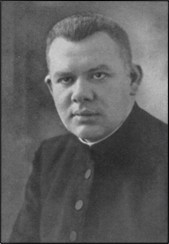Heinrich König (priest)
Heinrich König (born June 24, 1900 in Höchst ; † June 24, 1942 in Dachau concentration camp ) was a Roman Catholic priest and opponent of National Socialism . He is venerated as a martyr in the Catholic Church .
Life
Heinrich König's father, an engineer, moved with the family to Gelsenkirchen in 1902 and to Unna in 1906 . After Heinrich, the eldest son, six more siblings were born, three of whom died in childhood. 1918 Henry King put in Unna a high school, and then studied in Paderborn , Münster and Munich theology . He was a member of the Hochland student union in the Quickborn Bund . While still a seminarian , he joined the Schoenstatt Movement of Priests in 1923 and also met Josef Kentenich .
On August 10, 1924 King received in Paderborn Cathedral, the ordination . He became vicar in Hagen with the special task of collecting a community in Hagen-Emst . In 1926 the small Heilig-Geist-Kirche was built there, which was later converted into a parish hall and has been called Heinrich-König-Haus since 2002 .
In 1935, King became vicar at the St. Augustine Provost Church in Gelsenkirchen. Here he particularly took care of the parish youth, worked as a sick pastor, was President of the Kolping Family Gelsenkirchen-Zentral and gathered a group of lay people and a group of priests from the Schoenstatt Movement. Their magazine, Mater Ter Admirabilis , published several articles by him.

König had never made a secret of his distance from the Nazi regime. On September 30, 1941, he was denounced for making statements hostile to the state and arrested by the Gestapo . After several weeks in prison in Gelsenkirchen, he was taken to the Dachau concentration camp, where he arrived on December 5th. An operation for "practice purposes" that a young SS doctor performed on him in December brought him to the sick bed for months . In March 1942 he came to the pastors' block . There the SS selected him for further medical experiments. Under the supervision of Himmler's personal physician Karl Gebhardt , the wounded Nazi idol Heydrich died of an infection. Gebhardt got into trouble and tried to rehabilitate himself. The effectiveness of sulfonamides (antibiotics) should now be tested on concentration camp inmates. This happened in the Ravensbrück concentration camp and in Dachau. After deliberately induced sepsis (blood poisoning) by injection with pus on June 15, König was not treated and died nine days later. His body was cremated. In spite of Gestapo surveillance, many clergymen and community members from both places of activity took part in his funeral masses on July 2nd in Gelsenkirchen and on July 6th in Emst.
Appreciation
After the war, efforts to achieve adequate memory began. The square in front of the provost church of St. Augustine (and also the tram station below ) was given Heinrich König's name in 1987. On the distribution level there is a small exhibition from the Friends of Heinrich König , which is accessible at all times. In 1989 his urn was exposed for veneration by Cardinal Hengsbach in St. Augustine. A beatification process is in preparation.
The Catholic Church accepted Vicar Heinrich König as a witness of faith in the German martyrology of the 20th century .
literature
- Helmut Moll (publisher on behalf of the German Bishops' Conference), witnesses for Christ. Das deutsche Martyrologium des 20. Jahrhundert , Paderborn et al. 1999, 7th revised and updated edition 2019, ISBN 978-3-506-78012-6 , 574-577.
Web links
- Heinrich König in the Ecumenical Lexicon of Saints
- Internet presence of the Friends of Heinrich König
| personal data | |
|---|---|
| SURNAME | King, Heinrich |
| BRIEF DESCRIPTION | Roman Catholic priest and opponent of the National Socialist regime |
| DATE OF BIRTH | June 24, 1900 |
| PLACE OF BIRTH | Frankfurt-Höchst |
| DATE OF DEATH | June 24, 1942 |
| Place of death | Dachau concentration camp |

